This is a guest-post by Kelley Starr and contributor Jon Giacalone. Kelley is a partner at LeanTech Group, where he works as a growth accelerator and advisor to early stage digital companies seeking venture capital. You can connect with Kelley on LinkedIn, or Google+. Jon is the Digital Marketing Manager at Fishidy, a map-based fishing social network.
Drawing on Lessons Learned in a Startup Environment
In this post I’ll explore off-page SEO, link building and blogger outreach strategies in a dynamic digital startup environment. I cover venture-backed Fishidy, a map-based online platform for casual and serious anglers (60M in North America) in the $42B annual recreational fishing and angling market.
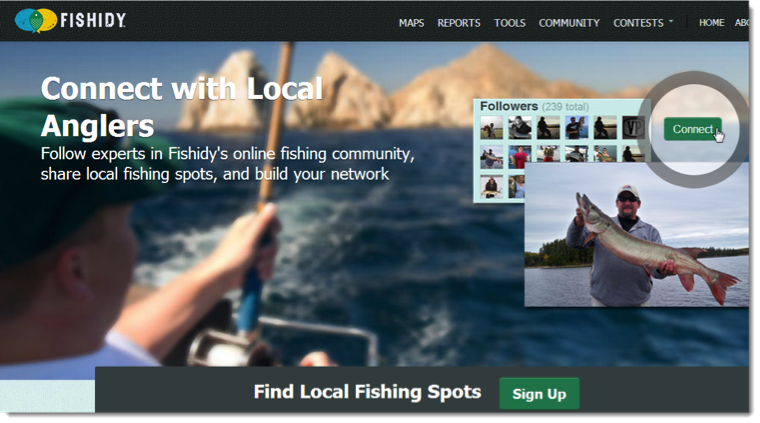
Fishidy’s core business model relies on converting site visitors to free members and a percentage of those to paid subscribers – a classic freemium to premium business model.
Although Fishidy is an early stage digital startup, the link building strategies executed below can be leveraged by influence marketers building brands at any stage of growth.
Fishidy had identified more than a dozen online and off-line channels in its sales and marketing roadmap to drive customer acquisition – each with its own cost and conversion assumptions predicted. Fishidy needed to test each and determine the most effective channels, but also discard those with the highest costs or performance metrics outside conversion goals.
Digital advertising (PPC) programs were already underway. Conversion rates were being monitored and optimized as an initial baseline to gain early traction. These were measured against on-page and off-page SEO channels which would take time to deliver new members and subscribers.
It was assumed in Fishidy’s business model that link building, influencer distribution and referral traffic would be a key growth driver. Like most companies, link building’s customer acquisition cost (CAC) was expected to be lower than paid search.
Identifying Link Building Targets
As a unique, fun and social online platform, Fishidy was a natural for classic link building tactics including:
• Guest blogging – anglers love an edge and the latest tools
• Editorial article mentions and coverage (digital PR)
• Product reviews
• Blog commenting
• Resource page links (lots of government and tourist sites reference fishing resources)
• And more…
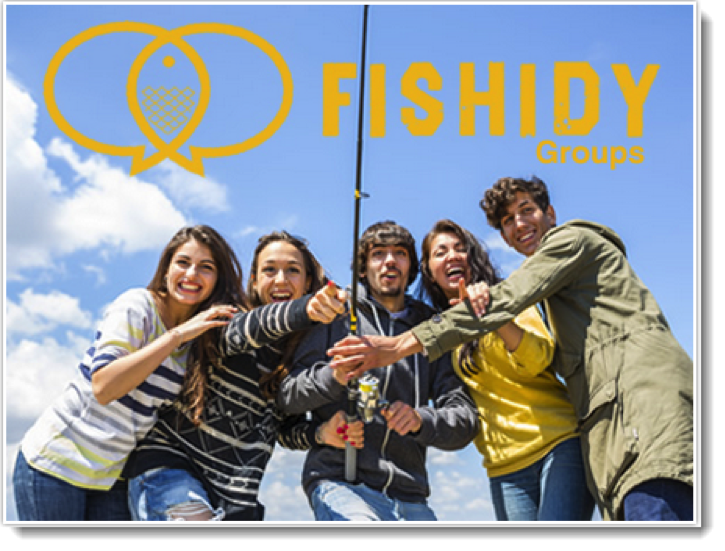
Each of the above was defined as one or more “value exchanges” with the targeted publisher, blogger, social connection or partner. Each value exchange target required different sourcing techniques, tools, outreach process and resources to acquire.
In addition to acquiring guest blog and article posts, Fishidy wanted to establish a national network of angling writers and influencers (ambassadors) by location, fishing type (bass, pike, fresh, saltwater) that could contribute to Fishidy’s social channels, news feed, local community and blog. As a side benefit the link building outreach program would uncover social influencers and build their angling community.
The Marketers Challenge – Time and Resources
BUILDING THE TEAM
Fishidy’s CEO and recently recruited marketing team (including Jon) had plenty on their hands at the busiest time of the year. Link building and community outreach was just one of many critical activities. It was important to guard the time of the team, but leverage them at key points throughout the outreach process. To fill out the team, a marketing intern was assigned and two part-time outside consultants would assist in the execution of the off-page brand referral program.
Jon took the lead from Fishidy’s team. I collaborated with Jon to build the strategy and test the process and execution.
Creating Strategy
To build our execution strategy, we had a number of decisions and discussions to build around. We found Basecamp to be a great platform to create key tasks, monitor discussions and document the process. The team was in three geographic locations and allocated time as needed.
Defining Project Funnel Stages
Next we looked at the milestone activities needed to execute Fishidy’s link building strategy, analogous to stages in a sales funnel. This would be critical for monitoring progress and ownership of assignments as we developed our influencer partnerships. Key milestones are listed below:
Sourcing involved the tools and processes to identify site and influencer targets out of the 1,000’s of potential suspects. Example: Google advanced search: fishing apps inurl:guest. Or tools like Citation Labs Link Prospector.
Researching involved reviewing, scoring, prioritizing and segmenting each suspect to get from 1,000’s to 100’s.
Outreach strategies and followup to qualified targets – email, social, phone (yes phone!)
Engagement – engaging with those that had mutual interest and defining the value exchange, initially 100’s and over time 1,000’s .
Partnership Acquired – defined the point where we had successfully established a relationship and defined a specific value exchange, i.e. guest post, product review, mutual social engagement, initially dozens scaling to 100s.
Tools For Execution and Scale
It was clear that something much more sophisticated than a spreadsheet was required to stay organized. Fishidy had a marketing automation platform in place as one option, but after a review of specialized outreach management tools, BuzzStream was evaluated and selected.
BuzzStream’s focus on link building research, contact discovery, outreach integration with company email and team collaboration could operationally scale with Fishidy’s expected growth. It was essential to keep data organized at the critical hand-off points to the virtual team doing the work.
Taking the stage and funnel approach further, the team exchanged a number of ideas and put more detail into the stage definitions documented below. The lower stages represented deeper engagement.
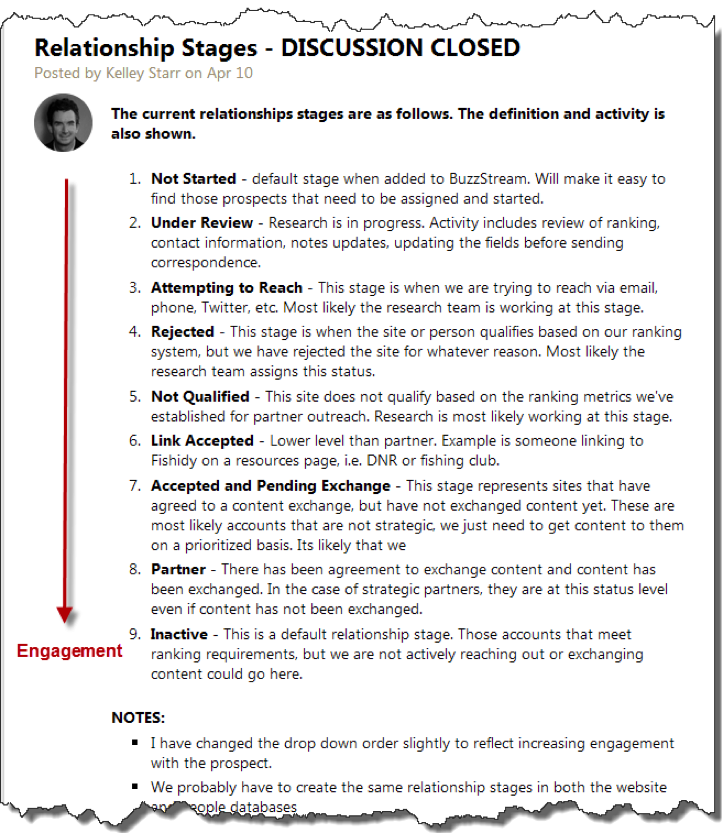
BuzzStream’s custom fields were then used to build the milestone definitions into the system.
You can see in the Basecamp screenshot below, we had a number of iterations and online discussions to build our plan quickly. Jon makes a great point that a conversion on a resource page is different than acquiring a link from a strategic partner.
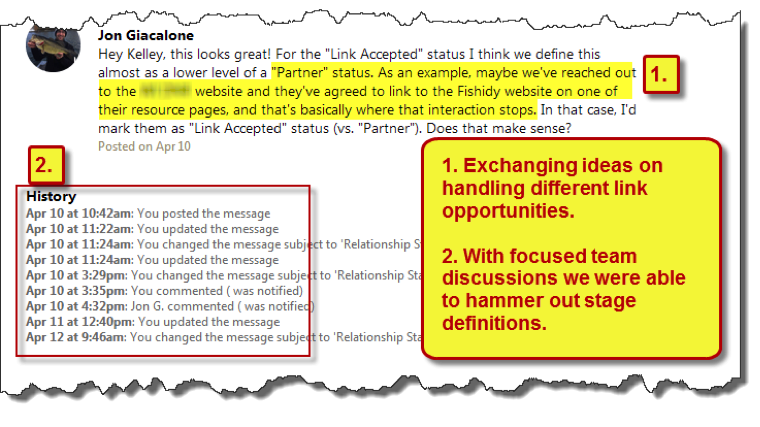
Assembling a Link Building Team With Roles
Using the defined relationship stages gave us a sense of what roles were needed for the team to move from 1000’s of targets, to selectively working with valued partners.
Defining roles was important since Fishidy would be adding staff with growth. Titles and names didn’t matter as much as what role would be used. This concept was important for the virtual team process as we launched. On any given day, any team member might have to jump into a role to move the process along.
Researcher – The researcher role could focus on a number of stages, including executing sourcing tactics, researching and reviewing targets and initial approaches through email/social outreach. Most of the work would be process and detailed oriented and required a full time effort. Automation could be used to scale. Fortunately this role could also be performed by a marketing intern at a lower cost.
Analyst – The analyst needed more experience than the intern and would assist on the outreach stage, developing relationships through email, social channels and phone, follow up and hand-offs to the strategic team (see below). Automated tasks were balanced with building one-on-one personal relationships. The analyst would also develop quality content as partners were identified.
Strategic Team – Focused on personalization and influencer engagement vs. automation. This effort required engaging with qualified targets, developing mutual relationships, defining partnerships and content development. The Strategic Team was time constrained and focused on the bottom of the funnel opportunities which were managed and handed off by researchers and analysts. The company opportunity cost is the highest with the strategic team.
With the roles defined, Jon assigned Fishidy’s internal team and external consultants (including me), to the project.
We used BuzzStream’s custom field option to map out the relationship stages. See below.
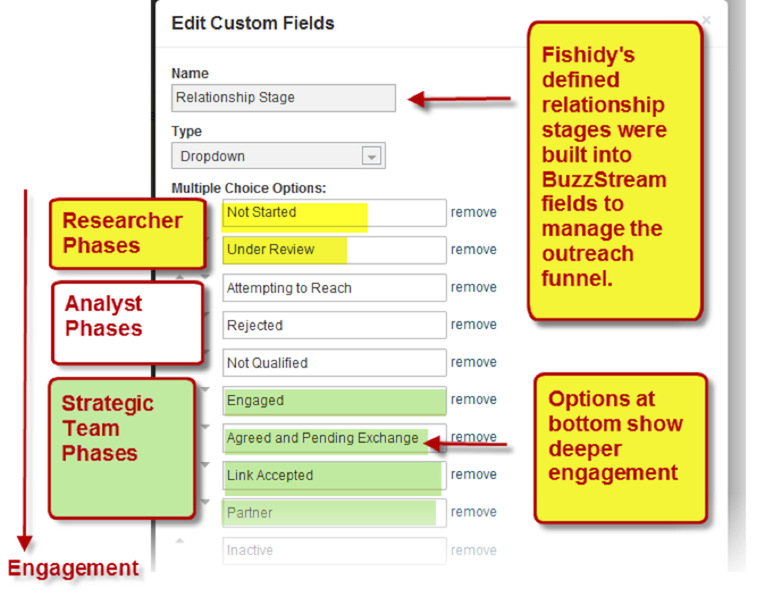
Jon and I played all the roles so we could go through each step of the process, determine friction points and modify as necessary so we could scale link building down the road.
For review, we built the ranking system below combining objective and subjective criteria.
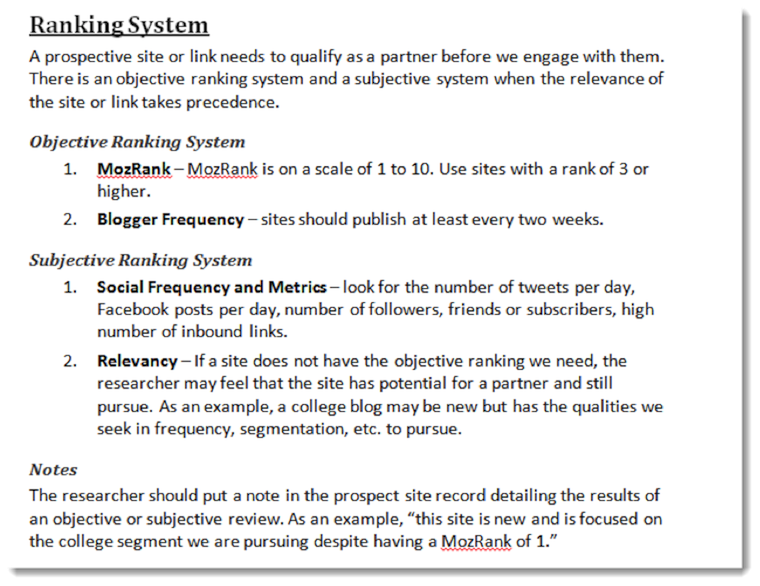
Monitoring Progress Through Filtered Views
As I mentioned, the team worked virtually and in spurts. It was necessary to make it easy to login to BuzzStream and quickly determine the state of campaigns and next steps. With filters and column sorts, each team role could focus on their targets. The screenshot below shows various stages and the role assigned.
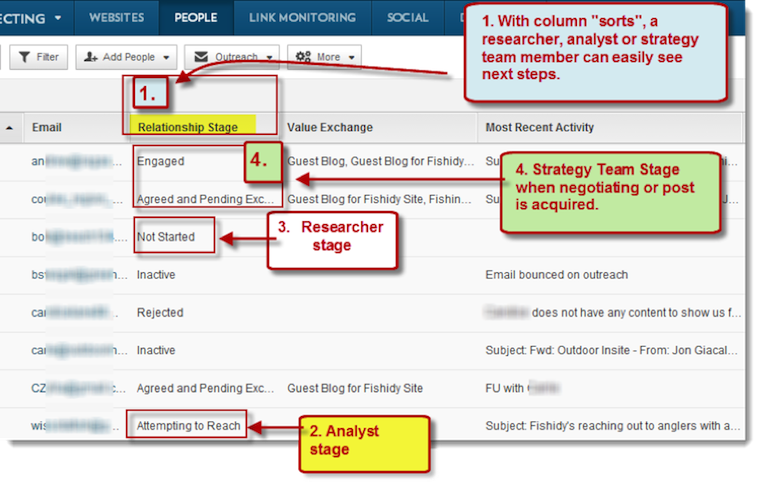
Campaign Illustration
To illustrate outreach process, I’ll cover a campaign we executed to test engagement in a localized market. Fishidy felt that each state had its own customer segment and local influencers to target. Many casual anglers stay within a two-hour radius of their home so locally generated content was of value to them.
A campaign was developed with the following goals:
• Target local angling bloggers and publishers for engagement. These writers may accept guest blogs, write reviews or create fishing reports and other content that could be developed for or syndicated through Fishidy.
• Some in this campaign could be recruited to publish their work as a “featured outdoor author” contributing to Fishidy’s national blog.
Sourcing
For this campaign, we targeted local outdoor, tourism and angling-related sites that used guest authors. This was supplemented with in-house lists from trade shows and local events. We created a CSV file and imported to a project within BuzzStream so the campaign could be managed.
Outreach
Outreach templates were created to scale the campaign. Along with email, we collected phone contact information for follow up. (Note: we found that phone follow-up increased our engagement by a factor of two.)
The image below shows a successful outreach and engagement with one of Fishidy’s eventual “featured outdoor authors.” All activity was captured through a BuzzStream email template and integration with Fishidy’s email environment. Following the email below, the Strategic Team was introduced to finalize the partnership expectations.
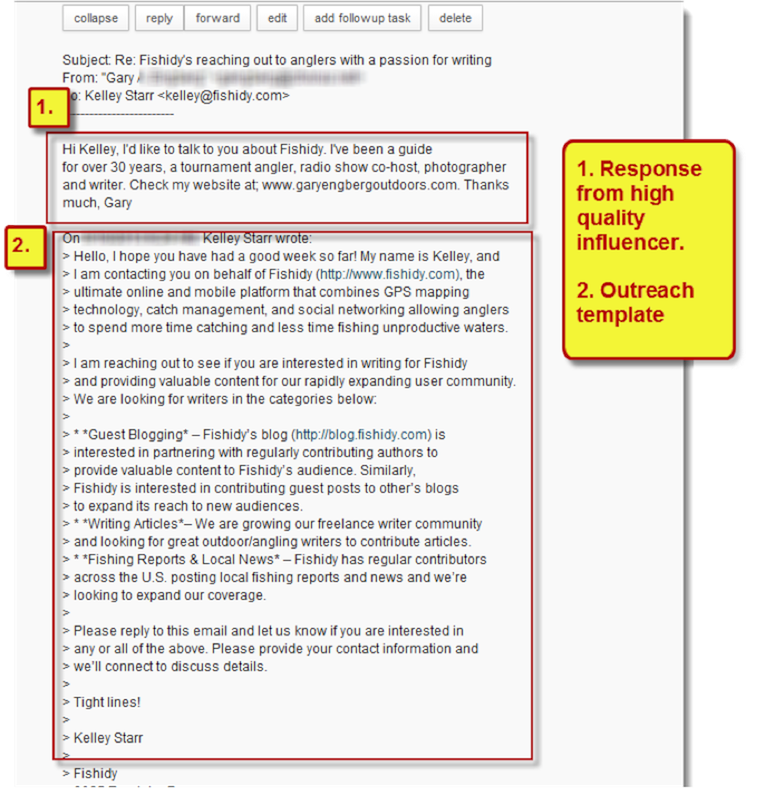
Getting Traction With The Model
Below is the Basecamp update on the campaign results with comments and additional feedback.
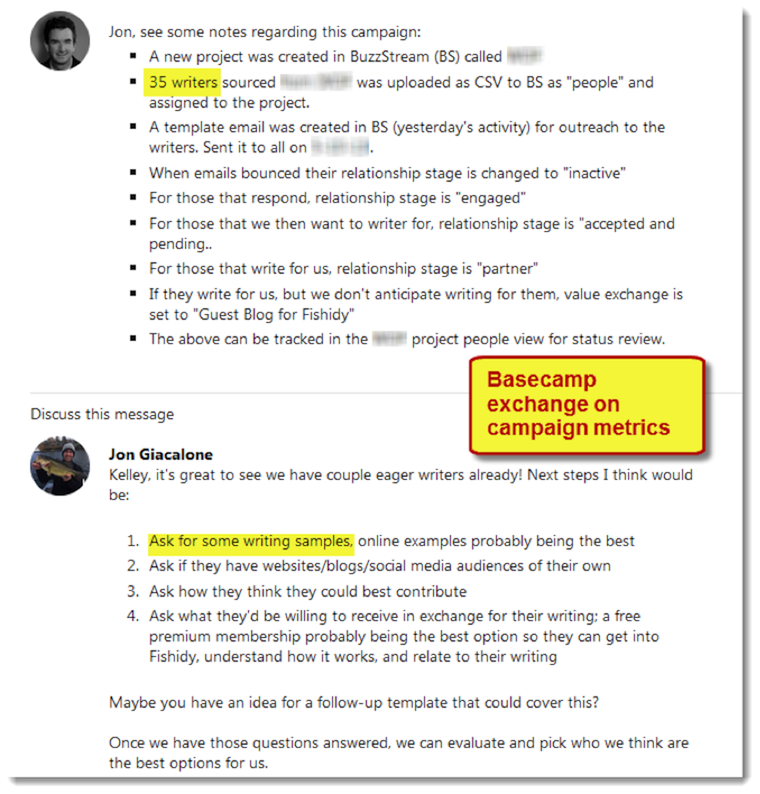
Measuring Results
With a strategy to test and scale link building strategies, Fishidy was able to validate the cost and effectiveness of referral and influencer marketing channels against other traffic building tactics.
On a year over year comparison period they were able to:
To Fishidy.com
• Increase overall referral traffic by 157%
• Validated a lower on target CAC for referral and social against a paid search baseline
• Increase traffic to fishidy.com from the blog by 660%
• Increase social referrals by 2,600% on Twitter and 292% on Facebook
• Acquire more than 60 resource links
To the Fishidy Blog
• Increase of 687% in organic traffic
• Increase in social by 630% on Facebook and 1,617% on Twitter
Whether you have a startup budget or the resources of a global brand, the strategies Fishidy used apply. Test your link building assumptions against other digital channels and make sure you have the tools and roles defined to scale for growth.

 End-to-end outreach workflow
End-to-end outreach workflow



 Check out the BuzzStream Podcast
Check out the BuzzStream Podcast

